Positively Darwinian
Posted on Jan. 11, 2018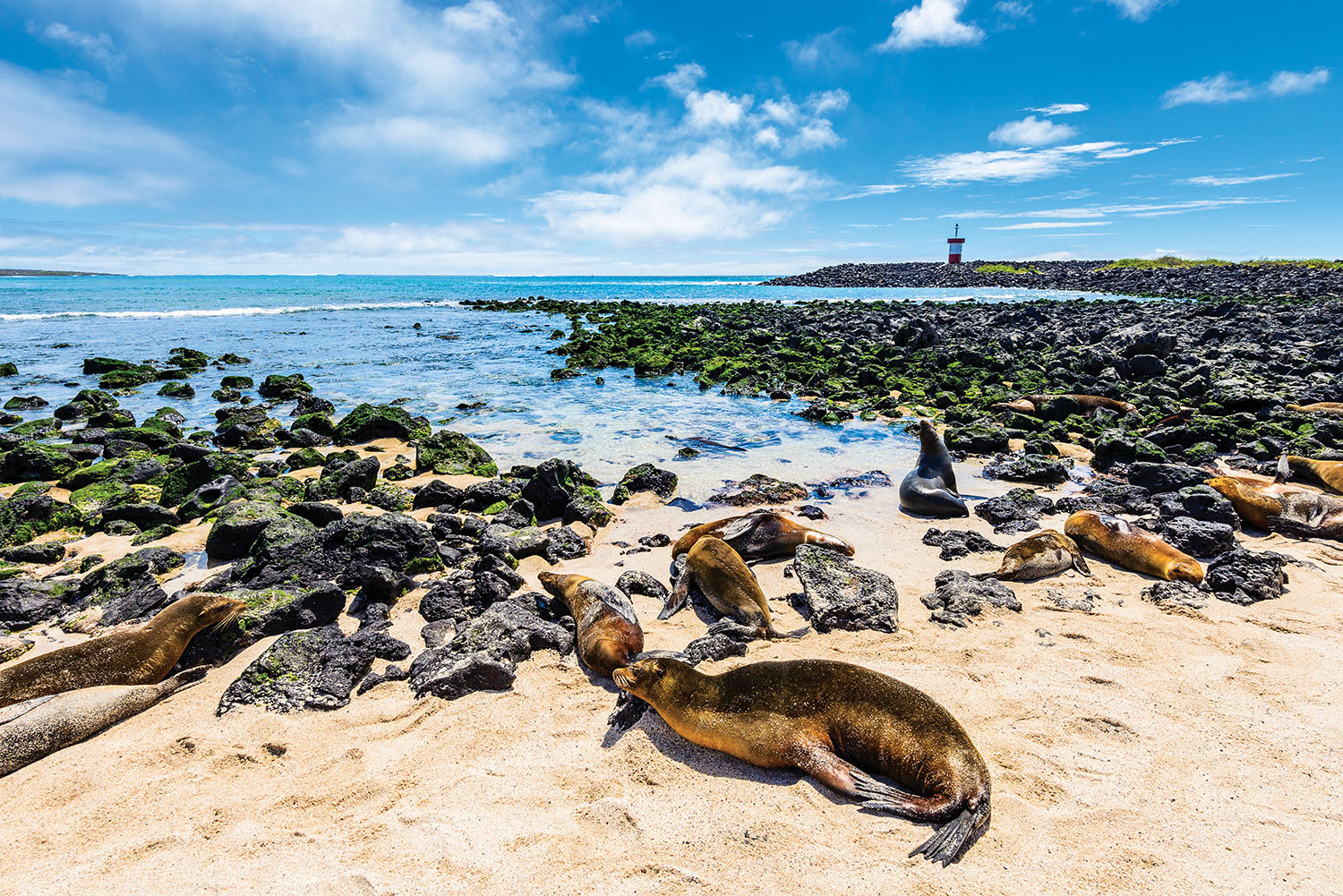
Sea lions, a green sea turtle and a marine iguana. Threats to their Galápagos habitat include the prospect of more frequent and more severe El Niño’s and pressures to accommodate tourism. (iStockPhoto/Albert Olovo)
Who will take up the enormous challenges of the delicate laboratory of Galápagos? Carolina got an exclusive admission, and now it must show that it is the fittest.
by Neil Caudle
In the panting-hot breath of early morning, as the sea lions bawl in the harbor, we heave our gear aboard a motorboat and settle onto benches for the ride. Soon we are bucking low swells near a shoreline where seawater shatters like crystal on black volcanic rock. We are rounding a headland of San Cristobal Island, hunting a sea turtle, hoping to catch it, equip it, release it and learn where it goes.
Why are we here? By one way of thinking, all of us humans should pack up and leave. We should lock the Galápagos away like a treasure — unplundered, pristine. But that ship sailed generations ago. Today, some 30,000 people reside on the islands, and more than 200,000 tourists visit each year. So the world’s foremost laboratory of evolution, where Charles Darwin watched nature select its survivors, shows the signs of decline: polluted waters, damaged ecosystems and threatened wildlife. More than half of the species that live here today are invasive.
Ecuador and its Galápagos National Park, the keepers of the treasure, want answers. Scientists, conservationists and wildlife lovers around the world want answers. How do we learn enough, fast enough, to save the Galápagos before people love it to death?
Take a video tour of the Center for Galápagos Studies.
The answers are largely up to us, meaning The University of North Carolina and its Ecuadorian partner, the Universidad de San Francisco de Quito. On paper, the two are a mismatch — a research powerhouse teamed up with a precocious little private university only 29 years old. But in the Galápagos, they work as one. Together they have opened the first and only academic research station in the islands. Richer and tonier schools have tried this and failed. They didn’t have Steve Walsh and Carlos Mena ’07 (PhD).
Carolina sunk its roots in this place because two decades ago Walsh, the well-traveled Lyle V. Jones Distinguished Professor of geography from Chapel Hill, and Mena, a cherub-faced novice from Ecuador, met in the Amazon jungle and began to incubate a grand idea. Walsh was investigating the causes of deforestation. Mena, fresh out of college, was surveying Amazonian farmsteads. Walsh offered him a job.
Today, Mena is a professor of geography at USFQ, and the men have grown closer than mentor and student, closer than friends. They are family. Walsh is the godfather of one of Mena’s daughters. As co-directors of the Galápagos Science Center, they are now also peers, sharing an office with views of a beach where the sea lions bask among locals with children in tow. Over the four brief years since the center came fully online, its influence has rippled forth into five books, 60 papers and various policy changes. But when Walsh and Mena step out to their deck overlooking the bay, they aren’t just admiring the view. They are bracing for everything yet to be done.
Two professors
Midmorning, we’re passing a shoreline so wild it could occupy another planet. Jet-black iguanas adorn the big rocks. Our pilot steers us into a cove, the mouth of it toothy with gleaming basalt. The depth finder beeps an alarm, the boat throttles down, and we pull on our wetsuits and fins. Juan Pablo Muñoz, a UNC-USFQ employee who studies turtles, hands the underwater video camera to Meredith Burke, a Carolina senior. “You take the pictures,” he says. She nods.
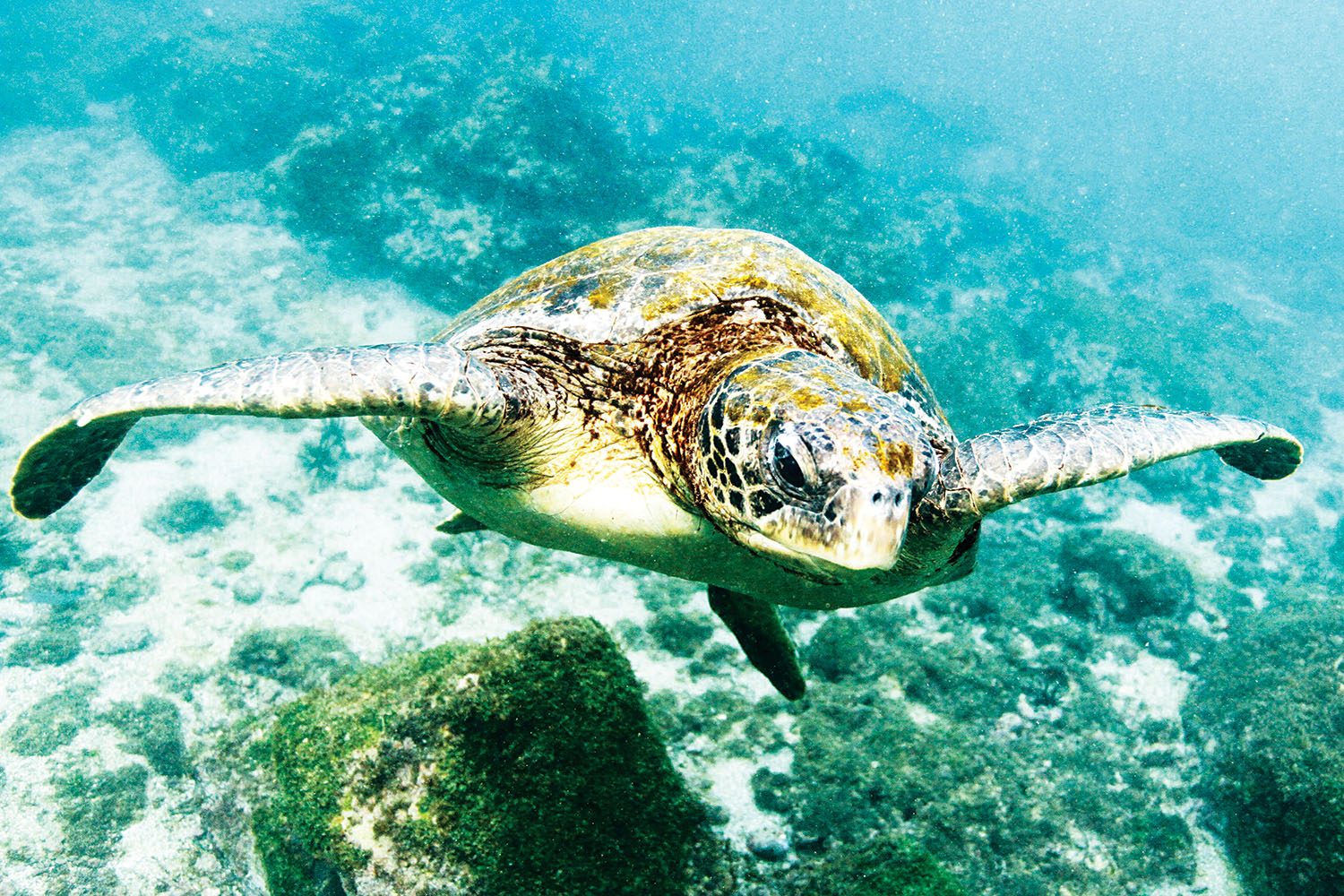
Sea turtles stir the imagination of Galápagos visitors. Researchers at the Center for Galápagos Studies capture the turtles — briefly — so they can track their movements using GPS. (Photo by Mary Lide Parker ’11)
We tip ourselves over the side and fan out across the cove, no sudden movements allowed. The secret to catching a turtle is calm. In Spanish, the word is tranquilo. We search until Muñoz whisper-shouts, “Aqui” — “Here.” He dives but comes up empty. The park ranger croaks, “Aqui,” and then dives — too late. The turtle is fast and the humans are slow. Surely we will fail.
Carlos Mena isn’t with us for the hunt. He’s more adept at wrangling the cooperation of public officials than of sea turtles. This week, he’s met with the director of the Galápagos National Park and the Ecuadorian minister of the environment, who stopped by the center to meet several dozen students selected for training as guides. The center teaches the candidates science because well-informed guides promote wise conservation.
Many academic researchers avoid that sort of entanglement; they gather their data and leave. For the locals, though, those scientists resemble the quick-buck artists who show up, exploit some resources, then escape with the loot. From the beginning, Walsh and Mena have worked to belong here, to listen and learn.
“People really care about this place,” Mena says. “We had to show them that we came here to stay.”
“People really care about this place. We had to show them
that we came here to stay.”
— Carlos Mena ’07, USFQ geography professor
Mena and Walsh have earned respect here with a unity of purpose but with contrasting styles. Walsh, who played three sports growing up in Massachusetts, is stubborn enough to butt heads over budgets and sturdy enough to brave the extremes of terrain, from the hot, snaky jungles of the Amazon to the rugged mountains of the American West. And Carlos Mena? He’s a born diplomat, the soul of tranquilo.
“He’s an open, sensitive guy,” Walsh says of Mena. “He’s never confrontational. I’ve spent a lot of time in Ecuador, but I’m of a different culture, a different mindset. So Carlos works with the government and the park.”
Mena first set foot on the islands 31 years ago, on a school trip to a beach called Playa Mann. Now he and Walsh — his doctoral adviser — share a second-floor office with a view of the very same beach, and Mena has closed the loop on his childhood dream of becoming a scientist.
These two men, and their respective universities, have defied the odds and built this gleaming new three-story marvel, with its 11,000 square feet of laboratories, offices and meeting rooms, complete with high-performance computing and solar panels on the roof. Landing that prize wasn’t easy. For a while there, we had ourselves a turtle hunt: aqui, aqui, aqui.
Darwin in the Galápagos
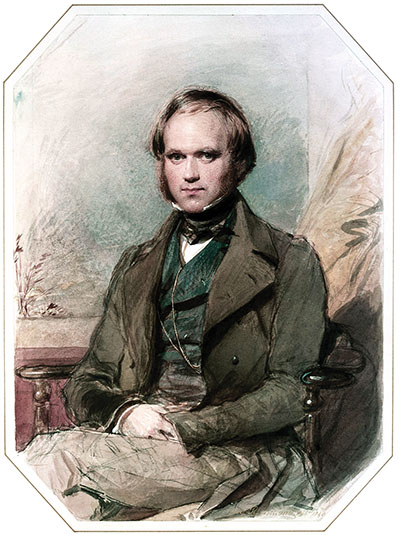
Charles Darwin
The 22-year-old Charles Darwin spent five weeks in the Galápagos in the fall of 1835 on the five-year surveying journey of the English ship HMS Beagle. At the time, he was a medical student and a divinity student, and he was equally unenthusiastic about both — his interest was in geology. In Darwin’s geological and biological observations of the islands, he was captivated by what he called “differences between the inhabitants of the different islands.”
He discovered several species of finches — different from island to island. Of 26 species of native birds in the Galápagos, 14 are known as Darwin’s finches. The finches helped him develop his theory of natural selection.
Finding Ainoa
Suddenly, there she is, a female as big as a bathtub. Muñoz and a friend, Buck Osegueda, hang on for dear life as the turtle surges, dragging them across the pool. Lunging past Walsh, she slaps him across the face with a big, meaty flipper. “Ow,” he says. “That stung. I’ll try not to take it personally.”
Soon she is safely at rest belly-down on the lid of the hold, a T-shirt draped across her eyes for calm. She sighs, and the park ranger trickles a pitcher of seawater over her head. She’s a mature adult, Muñoz says, maybe 50 or 60 years old. He names her Ainoa.
Meredith Burke jots notes in a log as Muñoz inspects the turtle, weighs her in at 240 pounds and declares her fit. Carefully, he installs the palm-sized tracking device, which won’t harm the turtle, he says. He checks the glue job and wakes the GPS. Burke hops into the water to film the release. As soon as the net drops away, Ainoa is gone like a shot. Each time she surfaces for air — every 30 minutes or so when she’s swimming — the gadget will beam her location to a satellite, and Muñoz can track her wherever she goes.
As the boat putters out of the cove, Burke settles back on a bench, sun-pinked and smiling. A senior in environmental studies and archeology, she will spend her semester taking classes at the Galápagos Academic Institute for the Arts and Sciences (GAIAS) and helping Muñoz with his turtle research.
Where will Ainoa go? People speculate that some of these yellow versions of green turtles swim thousands of miles, perhaps to Australia, but no one knows for sure. So it’s hard to predict their survival, as the turtles cross ever-more-perilous seas. Muñoz could lecture us about the perils, but no, he will show us firsthand.
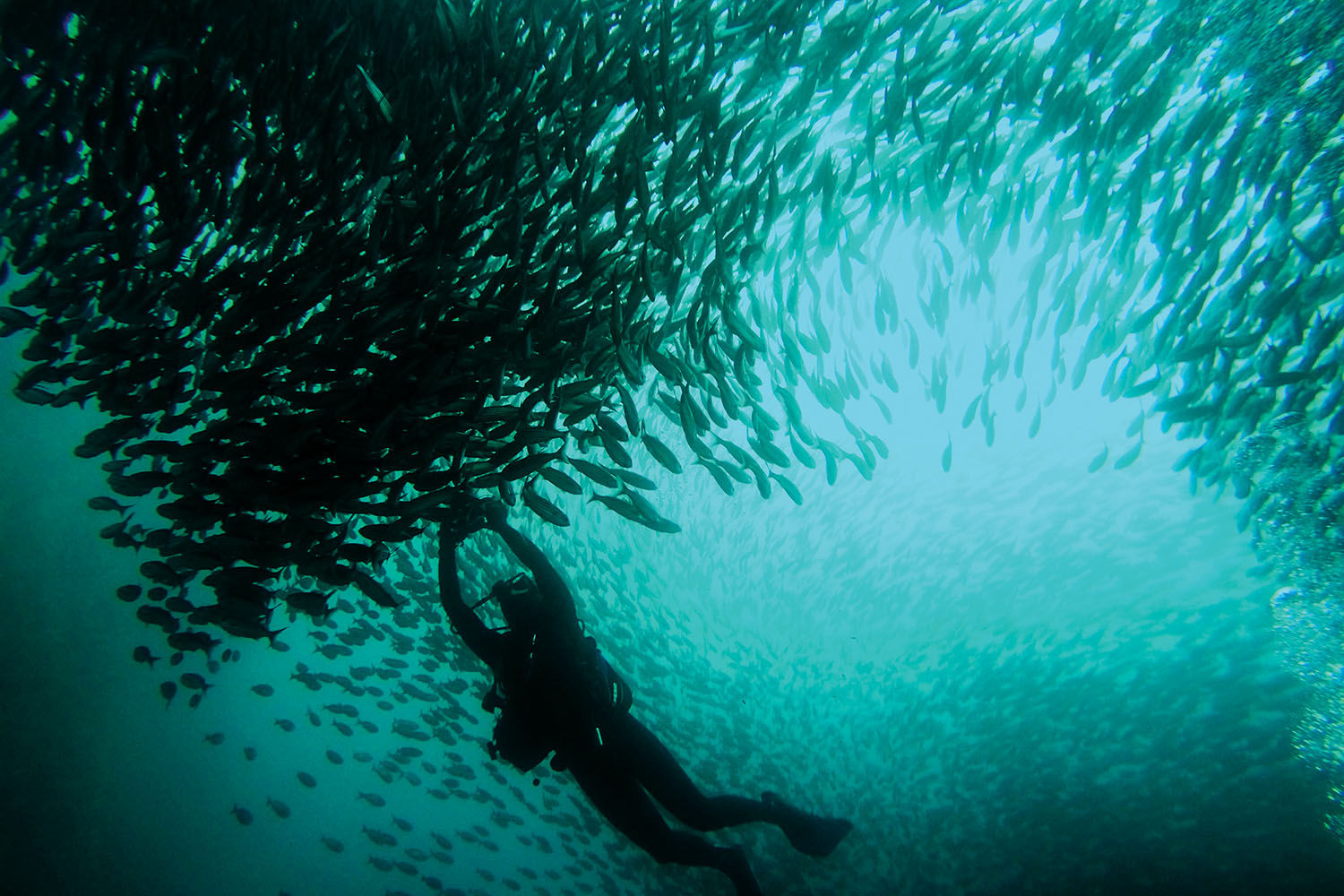
UNC-USFQ researcher Juan Pablo Muñoz takes photos from within a school of fish. (Photo by Mary Lide Parker ’11)
The grand idea
People versus nature — this is the conflict we’ve learned to expect from our stories of places like this. But the facts on the ground aren’t that simple. Carlos Mena learned that lesson early and applied it to the center’s mission — to conduct research that encompasses both sides of the equation: people and nature.
“I had experienced poverty,” he begins, “but nothing like the poverty I saw in the Amazon. My first assignment was to go into the forest and interview a young couple about my age. They had just had a baby, and they didn’t have anything to eat. They didn’t have potable water. They didn’t have anything except the forest. So I helped them cut down trees, just so that they could survive. It was against my education and what I believed, but they had to survive. So I saw firsthand the relationship between poverty and the environment.”
Like Walsh, Mena was learning that you couldn’t conserve a rainforest without understanding the people who were chopping it down. The same principle applied to the Galápagos. In 2006, when Ecuador realized that its golden apple was being tarnished by environmental degradation, it turned to Walsh for help.
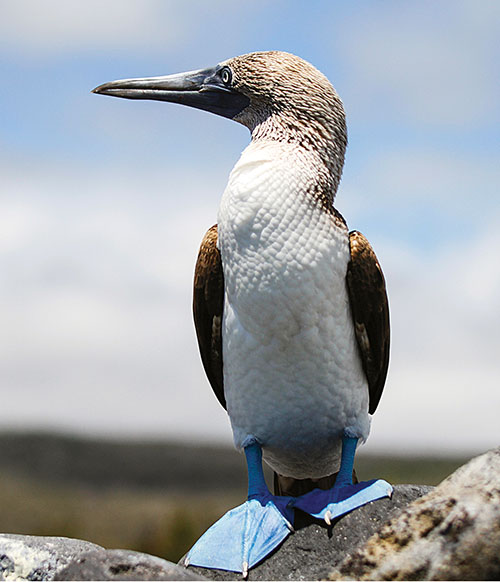
A blue-footed booby. (Photo by Mary Lide Parker ’11)
“They didn’t know what to make of a geographer,” Walsh says of his first visits to the Galápagos National Park. “They were used to biologists or botanists who would work at a very localized scale. But we function at the landscape level. We look at issues between and within islands, and we use satellite technology to build a chronology, to understand the trends.”
For decades, the islands’ magnificent wildlife — from the giant tortoises to the blue-footed boobies — had captivated scientists and tourists alike. But research in the Galápagos was daunting, and only a few intrepid souls had worked there long term. Studies of the islands’ foremost invasive species, human beings, were conspicuous by their absence. When Walsh and Mena arrived on the scene, the Charles Darwin Research Station, the only research center in the islands, did not have a social scientist on its staff.
In 1979, the islands became the world’s first UNESCO-designated World Heritage Site. Still, Walsh said, “no one seemed to recognize that the Galápagos was also a social cauldron affecting the environment in fundamental ways.”

Geographer Steve Walsh, left, is UNC’s ambassador to the Galápagos; Carlos Mena ’07 is the islands’ ambassador to the government of Ecuador. (Photo by Neil Caudle)
How many settlers and tourists could tramp ashore without crushing the life from this place? Walsh and Mena pulled data from various sources, plugged them into computer-based models and offered a range of management scenarios. Ecuador chose a low-growth option and began revising its policies.
But the work wasn’t done; the islands were constantly changing. So Walsh and Mena hatched their grand idea: to reveal, over time, the Galápagos in all of its vital dimensions. To do this, they would need collaborators from many fields. They would need labs and high-tech hardware. They would need a base of operations to house it all — a facility unlike anything ever constructed in the Galápagos. And they would need something like a miracle to pull it off. As a foreign institution, Carolina had zero chance of building in the islands. So that’s where the grand idea would have toppled and burned, if this story were rooted in logic alone. Three strokes of luck intervened.
Striving for sustainability
Our pilot veers around a wicked-looking spine of rock where dozens of blue-footed boobies are roosting, and we coast to a stop near the shore. A wrack of piled trash rims the beach, and more is bobbing shoreward from the sea. Here, on the unpeopled side of the island, the garbage seems outlandish, obscene.
“A current is bringing this here,” Muñoz says, “like an off-ramp from the gyre.”
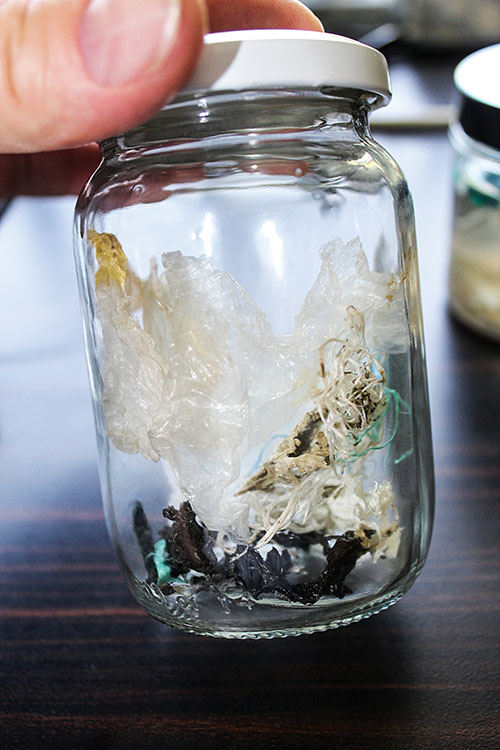
Tangled scraps and polymer grit that Muñoz found in the gut of a dead turtle. (Photo by Neil Caudle)
Ocean currents carry plastics for thousands of miles, swirling them into a soup of debris. On his office desk, Muñoz keeps a jar full of tangled scraps and polymer grit he found in a dead turtle’s gut. Ainao could die the same way. So don’t let Muñoz catch you with a plastic bag from the T-shirt shop or a web of bottled water. For him, all such plastic is lethal. And yes, it’s a slap in the face.
Like many Ecuadorians who live here, Muñoz respects and defends the endemic. Native animals, plants and people are a source of local pride. Even the local beer is called Endemica. Along the boardwalk of Puerto Baquerizo Moreno, sea lions lounge on benches engraved with Conservemos Lo Nuestro — “We conserve what’s ours.”
“The Galápagos is a unique place, and probably the best-conserved archipelago in the world,” Mena said. “It’s also a place where we are really close to achieving sustainable development. It’s a small population that wants to conserve.”
If the Galápagos can reverse its environment decline, Ecuadorians will do the heavy lifting, with scientists supplying some know-how. Faculty from both schools are working with locals to blunt the sharp edges of poverty, looking for ways to improve health care, sanitation, nutrition and education so that people can thrive and conserve what is theirs. Yes, there is an upper limit to the number of humans the islands can bear, but people don’t have to be nature’s enemies, Walsh says; they can become its defenders.
And the islands will need all the help they can get, because out there in the Pacific looms an even greater threat than garbage, a force that could wipe out the very endemics we cherish the most.
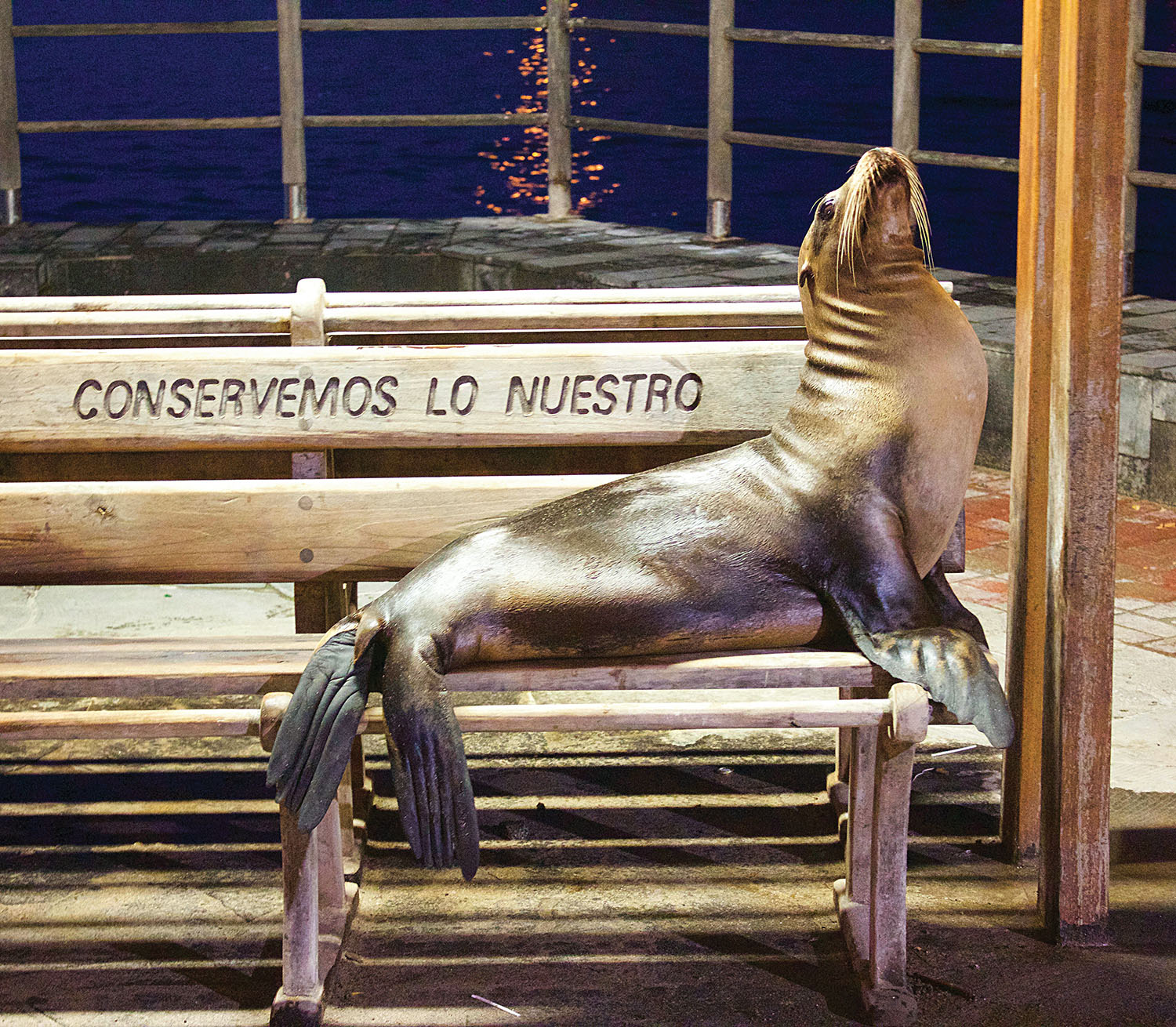
In the evening, sea lions take over the waterfront in Puerto Baquerizo Moreno. (Photo by Mary Lide Parker ’11)
The first stroke of luck came when Mena landed a job on the faculty of USFQ. Second, USFQ’s chancellor and co-founder, Santiago Gangotena, happened to be a doctoral alumnus of Carolina’s physics department (’78 PhD). Third, Tony Waldrop ’74 (’80 MA, ’82 PhD), then vice chancellor for research at UNC, took a trip to the islands, looked around and fell in love. Once Walsh and Mena shook hands and signed on, the grand idea had a shot. “Those guys had the guts to say, ‘Let’s do this,’ ” Walsh said. “ ‘Let’s find the money and do this.’ ”
The collaborators hammered out an agreement, but they needed a site. USFQ owned a parcel on Isabela Island, but logistics and local politics proved dicey, so they traveled to San Cristobal, hiked across a rocky slope behind GAIAS, USFQ’s outpost for teaching, and said, “Aqui.”
By piggybacking the research building on the institute, the project would qualify as an expansion, not a stand-alone structure. This made the task of obtaining permits and erecting a research building 600 miles from the mainland — on a craggy island with no deep-water port, where every bolt and beam had to float ashore on skiffs and little barges — insanely difficult. But not quite impossible.
A high-stakes environment
As we bounce over swells on our way back to town, I scan the long blur of horizon and consider what Walsh has said about the threats in that blending of ocean and sky. Scientists who study climate change have forecast more frequent and more severe El Niños, hooligans of climate that jack up the heat in an ocean that’s already growing too warm. El Niños block the upward surge of cool, nutrient-rich water from the Cromwell Current, starving the islands.
Hardship, of course, isn’t new here. The Galápagos environment, with its cycles of deluge and drought, has always been hostile, forcing the rapid selection that Darwin observed. “But if these El Niño events become more frequent and severe,” Walsh said, “then the animals that suffer from them most, like the Galápagos penguins, marine iguanas, sea lions and fishes, may not have time to recover when the food disappears.”

The research center built by UNC and USFQ began operations four years ago. In 2016, the partnership added Australia’s James Cook University. The center may sign another partner or two, but Walsh and Mena are keen to not overcrowd the facility. (Photo by Mary Lide Parker ’11)
So Walsh and his colleagues are hustling to monitor species and ecosystems before, during and after El Niños. What we learn from those studies, Walsh says, could help people manage the effects of global warming not only for the Galápagos but for island environments around the world — including the barrier islands of North Carolina.
So that’s one rationale Walsh can offer, when the budget-minders back home demand to know, “What’s in it for us?”
For Walsh, the payoffs seem obvious: How about the 30 or so UNC faculty members who use the center to advance their research? Or the dozens of UNC students who have studied in one of the most luminous natural laboratories on Earth? What about the prestige and strategic advantage of being the only U.S. university with a base in this premier destination for research? And what about the collaborations that cultivate allies for UNC around the world?
“Going there was the best decision I’ve made in my career,” Mena said. “UNC has given me everything.”
But back in Chapel Hill, the Galápagos research queues up with lots of other worthy causes pinched for cash. And prospects aren’t good for new federal funding, especially for science related to climate. So Walsh is hunting other sources. He needs seed funds to help researchers field-test new experiments and compete for long-term grants. And he needs additional equipment for managing biological samples and the genetics work that undergirds the life sciences today.
“We’ve been asked by the Galápagos National Park to be the caretaker of all things biological for the Galápagos,” he said. “We’re trying to figure out how to do that.”
Without a central repository — a biological bank of the Galápagos — a lot of good science could fall through the cracks, says Terry Magnuson, a geneticist and UNC’s vice chancellor for research. “We’ve learned from our work with human patients at UNC that we want to manage biological samples in a central facility that is controlled and secure,” he said. “I think we need a similar approach in the Galápagos.”
To share these and other costs, the center found a partner. In January 2016, it inked a deal with Australia’s James Cook University. The center may sign another partner or two, but Walsh and Mena don’t want to overcrowd the facility, so they also need donors who value conservation, the science behind it, and the intangibles you can’t tally up on a spreadsheet.
Mena takes a seat on a bench at Playa Mann, with the sunset ablaze on the ocean, and talks about some of those intangibles.
“Every summer my wife and I spend a month here with our daughters. Those times are the very best weeks of the year. During July, faculty members from both schools are working here, and their students are, too. So we are all here together, learning from each other. And it feels like a family. It really feels like a family. It’s just amazing.”
Neil Caudle, a freelance writer based in Chapel Hill, is former editor of Endeavors,
UNC’s magazine for research and creative activity.
Thanks for reading the Carolina Alumni Review
Carolina Alumni members, sign in to continue reading.
Not yet a member? Become one today.
